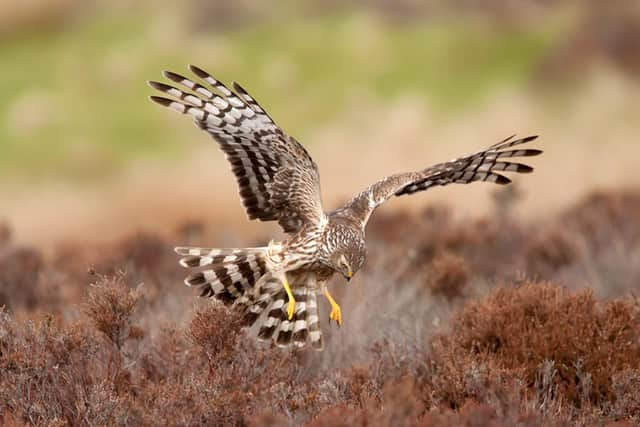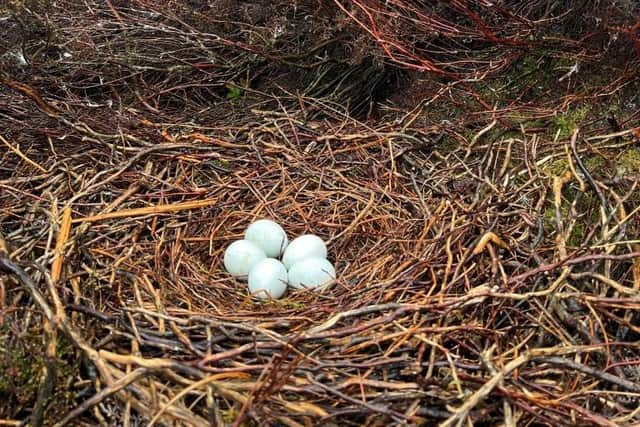'Final straw' as two hen harriers and 10 eggs lost on grouse shooting moor in Peak District
and live on Freeview channel 276
Peak District Raptor Monitoring Group said both were in the Upper Derwent Valley area of the Peak District National Park.
Raptor Persecution UK, a blog by conservationist Dr Ruth Tingay, said the nests were on a grouse shooting moor owned by the National Trust and leased to a tenant.
Advertisement
Hide AdAdvertisement
Hide AdShe wrote: “Two male hen harriers, both with active nests, have ‘disappeared’ in suspicious circumstances from a grouse moor in the Peak District National Park.”


It led to ‘two subsequent nest failures, both of which contained five eggs, when the females abandoned the sites earlier this month’.
The location hasn't been revealed because the hen harrier is a Schedule 1 protected species, she added.
It meant 70 hen harriers were confirmed ‘missing’ or illegally killed since 2018, most of them on, or close to, UK grouse moors.


Advertisement
Hide AdAdvertisement
Hide AdNational Trust general manager for the Peak District Craig Best said it was ‘deeply concerning’ and ‘indefensible these beautiful birds still face persecution’.
It is believed the trust has four grouse shooting tenants on its land in the High Peak.
He added: “The small number of grouse shooting agreements on land we care for must follow agreed best practice standards, the law and be consistent with our aims for access and conservation. We regularly review our approach to ensure all land management activity helps deliver our vision for nature and carbon.
“We want to see a landscape that is full of wildlife, including birds of prey, and we work hard with a range of expert partners to create the right conditions for these species to thrive. Over the past few years we have seen several instances of successful hen harrier breeding in the Peak District.


Advertisement
Hide AdAdvertisement
Hide Ad“While the circumstances around this incident are not yet clear, it is indefensible that these beautiful birds still face persecution.
“The incident has been reported to police and we are working closely with statutory agencies and the RSPB to find out what happened.”
The Star contacted The Peak District National Park and Derbyshire Police.
BUSINESS NEWS: This is why Kelham Island Brewery shut down
Luke Steele, executive director of conservation campaigners Wild Moors, said it was the latest in a ‘long line’ of persecution incidents on the National Trust’s Dark Peak Estate over the last decade.
Advertisement
Hide AdAdvertisement
Hide AdHe added: “Whilst we welcome the recent steps taken to tighten up the rules on grouse shooting, the Trust must face the facts that for as long as grouse shooting continues on its land so does bird of prey persecution.
“This latest incident must be the final straw which results in grouse shooting being ended on National Trust land.”
The Trust had recently completed a review of its grouse shooting leases for the High Peak Estate and had tightened its rules, he added.
Measures included an end to the use of ‘medicated grit’, a ban on trapping and snaring mammals and birds to increase grouse numbers for shooting, and a ban on heather burning.
BUSINESS NEWS: Eerie pictures inside empty Debenhams
Advertisement
Hide AdAdvertisement
Hide AdHe added: “Other landowners have actively banned grouse shooting including Sheffield Council on Burbage, Houndkirk and Hathersage Moors, whilst some are actively reviewing grouse shooting leases, including Yorkshire Water, and tightening up the rules surrounding how their land is used, United Utilities. Those landowners have also banned burning.
It is not the first time that hen harriers have gone missing on land in or close to Sheffield’s countryside.
In February, police were called in after a Hen Harrier went missing from its habitat near Stocksbridge.
It was never found despite being fitted with a satellite tracking tag by the RSPB in 2021.
Advertisement
Hide AdAdvertisement
Hide AdIn 2018, the RSPB said a bird called Octavia, which bred from a nest in the Peak District that summer, was one of three such birds to suddenly disappear.
Octavia had also been fitted with sophisticated satellite trackers, which they said normally keep transmitting and are found if the birds die due to natural causes.
BUSINESS NEWS: Thumbs up for towers to replace Debenhams
A spokeswoman for Sheffield City Council said they had banned all blood sports on their land in 1982. And a ban on moorland burning had been in place ‘for at least 10 years’.
She added: “The council’s Ecology unit bases its decisions on current science. The EMBER study from Leeds University clearly highlights the negative effect of moorland burning on our ecology and hydrology. We do not support moorland burning for this reason.”
Advertisement
Hide AdAdvertisement
Hide AdThe EMBER (Effects of Moorland Burning on the Ecohydrology of River basins) report states that heather burning on moorland, which is practised predominantly to support red grouse populations for gun sports, has ‘significant negative impacts on peat hydrology, peat chemistry and physical properties, river water chemistry and river ecology’.
Dr Lee Brown, from the School of Geography at the University of Leeds, who led the study, said: "Until now, there was little evidence of the environmental impacts of moorland burning. Yet, many moorland owners and individuals who hold sporting rights to the land have felt pressured by regulators and conservationists to change their burning regimes.
“Unsurprisingly, a push away from moorland burning – a practice that started in the UK about 100-150 years ago – without solid scientific evidence to back up the need for change has created a lot of tension. The findings from the EMBER project now provide the necessary evidence to inform policy.”
